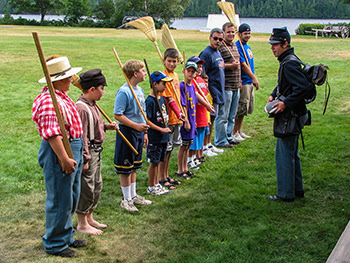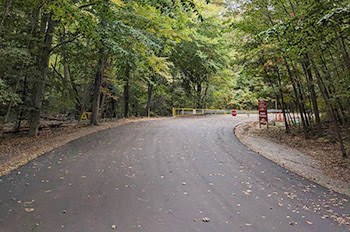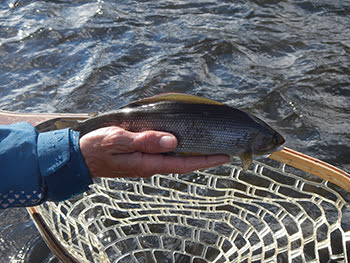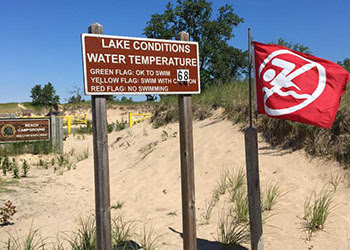Making your own snowshoes at Michigan state parks
Craig Kasmer begins with a warning: You will face challenges.
“This isn’t the easiest thing to do,” said Kasmer. “I’ll be up front about this. Some of you will have issues. Some of you will think you don’t have issues, but you do.”
So what are we talking about here? Navy SEALs training? Rebuilding a ’57 Chevy? Undergoing psychotherapy?
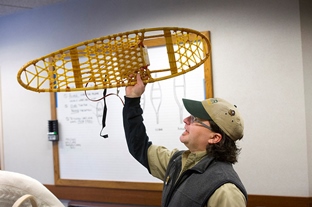 Nope. Kasmer, the interpreter at Hartwick Pines State Park in Grayling, Michigan, is talking about making snowshoes.
Nope. Kasmer, the interpreter at Hartwick Pines State Park in Grayling, Michigan, is talking about making snowshoes.
For the last eight winters, Kasmer has hosted three weekend classes (in December, January and February) on building snowshoes. The students begin with the basic materials – a wooden frame, some lengths of tubular nylon, and a set of bindings – and by the end of the weekend, they’ll have a self-made pair of snowshoes ready to be varnished and used to negotiate the winter outdoors. The workshop currently costs $175 per student, includes all necessary materials, and comes with Kasmer’s personal warranty on the product.
The class and similar others at a number of Michigan state parks are among the most popular hands-on winter activities offered by the Department of Natural Resources. This year’s classes are full, but there will be plenty of opportunities next winter. (Follow the DNR calendar to learn about classes like these and other upcoming events at Michigan state parks, historic sites and museums.)
The earliest example of mankind’s attempts to make conveyance over snow easier, snowshoes have been around for at least 4,000 years, far longer than skis. Snowshoes are thought to have been invented in central Asia, though the version most are familiar with – the webbed overshoes that we see today – was perfected by the indigenous people of North America.
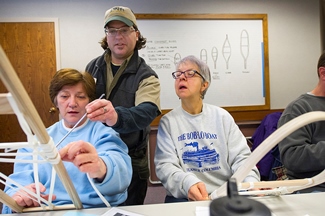 Snowshoes have a simple premise: spread the weight of a body over a large enough area so that it can remain atop of the snow instead of sinking down into it. They make traversing the snow, if not easy, at least easier.
Snowshoes have a simple premise: spread the weight of a body over a large enough area so that it can remain atop of the snow instead of sinking down into it. They make traversing the snow, if not easy, at least easier.
At a recent event at Hartwick Pines, Kasmer guided 11 people through the process. It’s an energy-intensive affair as Kasmer scampers like a red squirrel from student to student to student, answering questions, correcting errors and offering encouragement. His delivery is half stand-up comedian, half elementary school teacher, a mixture of wry observation and manufacturing mantra.
“It’s over the top, behind the bottom,” he chants, like a nun drilling first-graders on their ABCs, as he explains how to attach the nylon to the frame. “Under the diagonal, over the horizontal,” he says as he describes the way the webbing is weaved.
Most of the participants in the weekend workshops arrive in pairs; husbands and wives, buddies, or parent and offspring. But Kasmer discourages young children, as the work can be very frustrating. Fact is, it’s no piece of cake for adults.
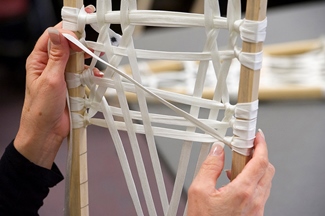 Bob and Veronica Henderson, from Lewiston, said they’d tried in previous years to come to the workshop, but couldn’t ever get it scheduled until this year. The pair are experienced snowshoers and own metal shoes.
Bob and Veronica Henderson, from Lewiston, said they’d tried in previous years to come to the workshop, but couldn’t ever get it scheduled until this year. The pair are experienced snowshoers and own metal shoes.
“We wanted the real ones,” Veronica said.
So why not buy them?
“It’s the novelty and a chance to visit Hartwick Pines,” Veronica said. “And it’s a way to add to the frustration in our lives.”
Indeed, builders begin with a 45-foot length of nylon to build the base – one of three sections of webbing – on the snowshoe. Tie an incorrect knot or miss a weave, and you’re taking out the whole length of nylon to try it again.
John and Kellie Remier, an engineer/school teacher couple from New Haven (Macomb County) drove up to the Pines for the second year in a row.
“We visited last year, borrowed snowshoes and enjoyed it,” Kellie said. “Last year’s class was full so we came up this year.”
“It’s interesting,” John said. “You can’t lose track of where you’re at.”
“You’ve got to stay on top of it,” Kellie agreed.
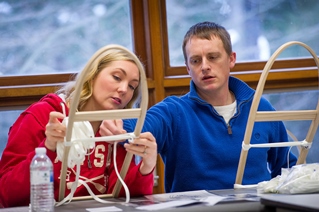 Most participants are finished with their first shoe by the first afternoon and beginning the second. It’s rare that a student finishes the pair in one day.
Most participants are finished with their first shoe by the first afternoon and beginning the second. It’s rare that a student finishes the pair in one day.
“Some people will be here late Sunday night,” Kasmer said. “That’s OK; I’ll be here.”
For his part, Kasmer can sit down and build a pair of shoes in a couple of hours. But he’s the unique individual who picked up on the technique right away.
“Before I was into forestry I was in fine arts,” he said. “I caught it quickly. I’ve got an over-developed right side of my brain.”
Snowshoe builders have to be willing to postpone their gratification; even after the shoes are completely built, there’s an additional step that must be completed before the shoes are fit for snowshoeing. The whole product must be varnished.
The varnish not only protects the wood, but also tightens up the webbing. And it gives the shoes the appearance of those stringed with gut, the way the American Indians used to make them.
Over the course of his snowshoe-building career, Kasmer said, there was only one pair of students who didn’t complete the task. It was a pair of buddies who’d been gifted the session by their wives and really weren’t interested in the project. Kasmer finished the shoes for them.
“Another nice thing about this workshop is that if anyone ever has maintenance or repair issues with their shoes, they can always call me up and I’ll be here to assist them,” Kasmer added.
Anyone interested in being added to a registration list for next year’s snowshoe-making classes should email Kasmer at kasmerc@michigan.gov. For more information on this and other winter activities at state parks, visit www.michigan.gov/stateparks.

